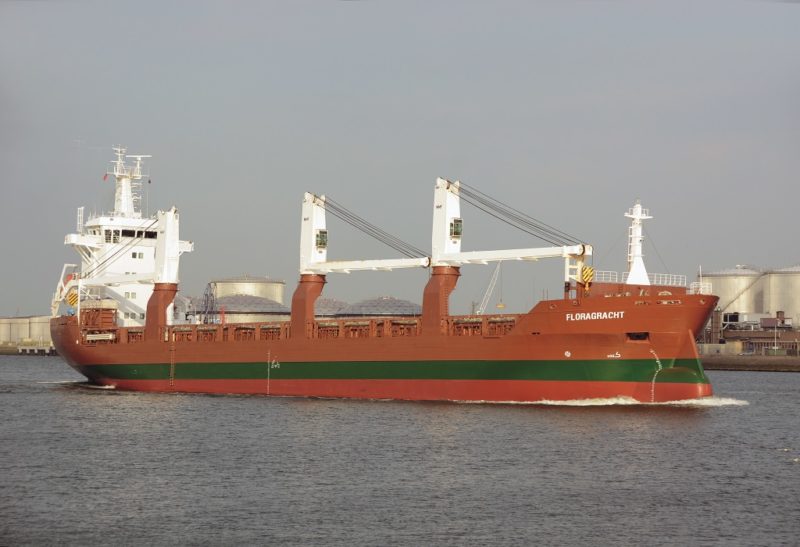
Today, the Spliethoff’s Bevrachtings-kantoor B. V. (Chartering Office) is located in Amsterdam in their skyscraper Radarweg Head Office with 1,152 employee office workers generating sales of around €400 million per annum, with 80% of turnover coming from shipping and 20% from logistics. The larger Spliethoff Group has five main shipping subsidiaries and 116 companies in the corporate family, together with a vast and worldwide network of shipping and logistics trade routes. A big fleet of 125 ships crewed by over three thousand seagoing personnel transport timber, paper rolls, pulp and other forestry products, ores and other bulk and general cargoes, wind turbines, project cargo, yachts, and other heavy lifts up to 2,200 tonnes in both the coastal and deep sea trades. Group vessels have Dutch Masters and deck and engineering officers, and crews supplied by subsidiary companies in Manila, St. Petersburg, Kherson (Ukraine) and Tallinn in Estonia until the Ukraine war.
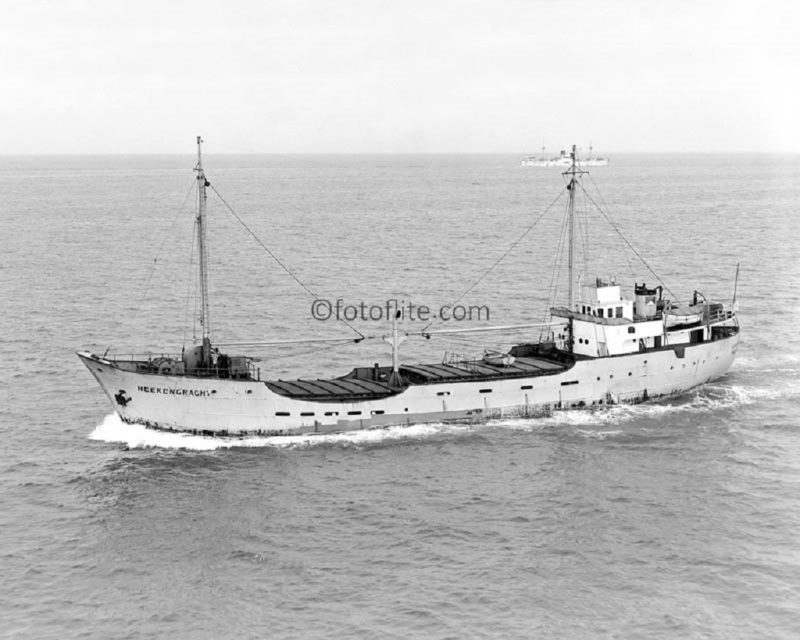
SPLIETHOFF’S BEVRACHTINGSKANTOOR B. V.
Spliethoff’s are well known in Amsterdam in the timber trades, and began as shipbrokers and freight forwarders in 1921 in the inland trades of the Netherlands. They moved into shipowning in 1946 with Dutch motor coasters in European waters, and later acquired larger deep-sea ships to extend their operations worldwide. All Dutch shipowners were helped by tonnage limits of a maximum size of 499 grt between 1945 and 1971 to qualify for a minimum crewing level of five or six men. In 1971, the maximum size of vessel of 1,599 grt was adopted by Holland and most international countries in order to qualify from exemption from carrying a radio officer.
Spliethoff’s also managed a large number of coasters for other Dutch owners, supervising around sixty other vessels, mostly ‘paragraph’ coasters of 499 grt built in Holland and Germany that could be crewed by their owner/skipper and four other crew. They carried coal, general cargo, bulk cargo, timber and forestry products around the Baltic and North Seas. These and other similar agencies, including Wijnne Barends, that was later taken over, operated as ‘Vertraunsmakler’ or ‘Agent’ as an onshore agent to charter, operate and cost account the coasters for the owner/skipper serving at sea.
In 1946, Herman Spliethoff, son of Johan Frederik Spliethoff, ordered and took delivery of his first motor coaster, Keizersgracht of 499 grt, completed that year at Waterhuizen and powered by a 6-cylinder Werkspoor diesel. His father, Johan Frederik Spliethoff, had been a shipbroker specialising in forestry products since 1921 with an office beside the Keizers canal or ‘gracht’ in Amsterdam. The Waterhuizen built motor coaster Heerengracht of 493 grt was purchased later in 1946, and Prinsengracht of 499 grt was completed at Zaandam in 1948, and Lucas Bols of 499 grt was managed for Erven Lucas Bols from 1949. The Spliethoff’s fleet of motor coasters, all of 499 grt, numbered sixteen in 1962, with eight owned and eight managed, the owned ones had names ending in ‘gracht’ e.g. Keizersgracht (2) completed by the Van Diepen yard at Waterhuizen in 1960. This twin hatch coaster was sold in 1971 to Italian owners and renamed Elviscot, and was lost on 10th January 1972 after grounding on Elba, her crew was saved.
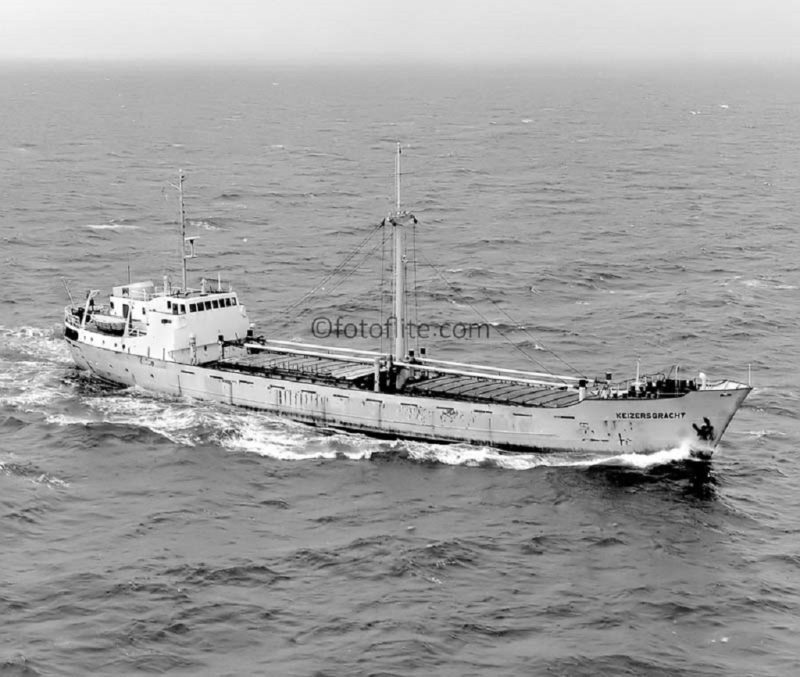
In post-war years, regular feeder services were begun to Finland, U.K., France, Portugal, Spain, Morocco, Italy and other Mediterranean countries. More Dutch motor coasters of 499 grt were completed at yards at Martenshoek, Foxhol, Waterhuizen, and Hoogezand for Spliethoff’s during the 1960s to increase the fleet to 22 Dutch motor coasters by the late 1960s. Genca of 498 grt and 1,040 dwt was launched on 10th May 1961 by the Bodewes yard at Martenshoek for Spliethoff and was completed later that year. She had dimensions of 68.64 metres by 10.32 metres by 6.15 metres with a single hold and a central mast carrying two derricks. She had a service speed of 10.25 knots from an eight cylinder Werkspoor diesel engine. She was sold in 1971 to Julio Villdiego and renamed Don Julio and traded from the Isla San Andres in Colombia. She was laid up on 15th April 1992 on this island in poor condition and was broken up in the following year.
Leliegracht of 1,128 grt completed by the Van Diepen yard in 1967 gave only six years of service as she capsized and sank on 28th September 1973 after her cargo of sodium carbonate had shifted in heavy weather while on a voyage from Antwerp to Pitea in Sweden, six of her ten crew were saved but four unfortunately lost their lives. In 1969, the Dutch Government introduced new manning regulations, based on length rather than tonnage, with most Dutch coasters up to 60 metres in length crewed by six men and the larger ones of up to 75 metres crewed by eleven men. The first larger size Spliethoff’s coasters to comply with the 1,599 grt ‘paragraph’ limit without carrying a radio officer were Heerengracht of 1971 and Keizersgracht (3), the latter completed in 1972 as Mini Sun at Kristiansund and purchased during 1973.
By 1977, a fleet of ten Dutch motor coasters all of 1,599 grt was operated with names ending in ‘gracht’ e.g. Lindengracht completed in 1976, and Lijnbaansgracht completed in 1977 with two pedestal cranes for cargo handling. Gradually, the Spliethoff’s fleet edged up in size to carry larger cargoes of 3,500 tonnes of timber by 1980, and to 4,550 tonnes of timber by 1982 with a ‘H’ class of Heemskerkgracht, Heerengracht, Hudsongracht, Humbergracht and Houtmangracht, and to 5,000 tonnes of timber by 1985 with a ‘K’ class of Kaapgracht, Klippergracht, Keizersgracht (4), Koggegracht and Koningsgracht. The company had increased the size of the fleet to a large one of 35 owned Dutch motor coasters, all with names ending in ‘gracht’, by 1985 and eleven more vessels than 5 years earlier.
A big series of sixteen larger multi-purpose deep sea traders of 6,100 grt and 9,590 dwt was then completed for the company by the Miho Zosensho yard at Shimizu in Japan between 1985 and 1989, although some examples were not purchased until 1992 from Russian owners. The ‘P’ and ‘L’ classes were equipped with two 50 tonne cranes and could also carry 565 TEU of containers, and were used extensively in the Far East, Indian and South African bulk trades. Palmgracht, Prinsengracht, Paleisgracht, Pijlgracht, Pauwgracht, Pietersgracht, Poolgracht, Parkgracht, Lauriergracht, Leliegracht, Levantgracht, Lemmergracht, Lijnbaans-gracht, Lindengracht, Looiersgracht and Lootsgracht gave up to twenty years of service to the company. The Miho Zosensho yard completed a huge total of 59 similar vessels to this specification on dimensions of 113.0 metres by 19.0 metres with a service speed of fourteen knots. Most of the ‘P’ and ‘L’ classes often unloaded their cargoes of timber in the King George Dock at Hull, and after giving twenty years of service were sold on to overseas owners for further service.
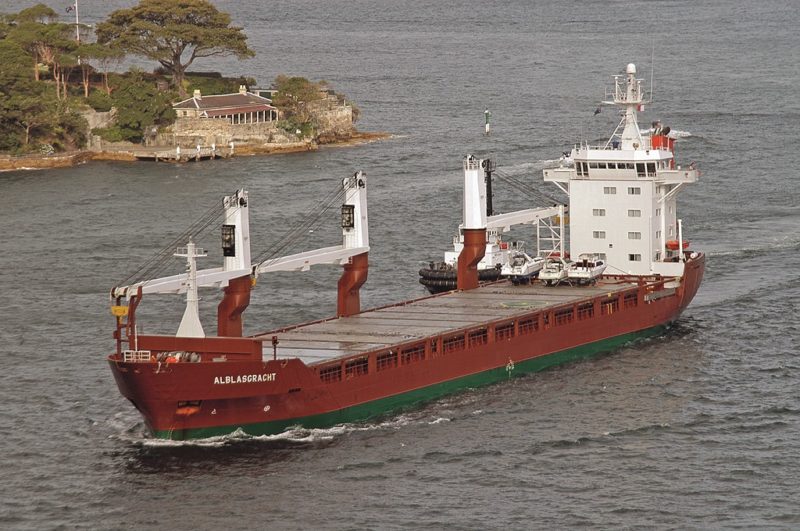
The last two ‘L’ class in service with the company, Lindengracht and Lootsgracht, operated an unusual ‘split personality’ existence in two distinct areas of operation for a number of years from the Canadian Arctic ice free season of 2007, which lasts from June to November. They supplied Canadian Arctic ports with vital supplies for the Nunavut Eastern Arctic Shipping Inc. (NEAS) based in Montreal. These two ice class 1A Spliethoff’s vessels were renamed Umiavut and Avataq respectively for this short season, and then returned to European trading in winter to regain their ‘gracht’ names with port of registry as Amsterdam. Avataq is the Inuit Eskimo name for a float attached to a harpoon line to prevent a harpooned seal from sinking, while Umiavut means ‘Our Ship’. They were managed by Transport Inukshuk Inc. for the ice free season and operated under Canadian registration. On 21st August 2009, Umiavut sailed from Montreal on the first ever commercial navigation of the North West Passage by a Canadian vessel, reaching the remote western Kitikmeot region of Nunavut including Cambridge Bay, Kuglutuk, Taloyoak and Gjoa Haven.
A large fleet of 44 short sea traders in 1990 included a dozen of the latest ‘A’ class of 7,949 grt and 12,200 dwt and constructed by four Dutch yards at Harlingen, Kinderdijk, Krimpen and Kootstertille. They were equipped with three 40 tonne cranes and could also carry 680 TEU of containers at a service speed of 15 knots from 12-cylinder four stroke Wartsila diesels. The ‘A’ class of Aalsmeergracht, Achtergracht, Admiralen-gracht, Anjeliersgracht, Alexandergracht, Artisgracht, Archangelgracht, Amstelgracht, Alblasgracht, Apollogracht, Ankergracht, and Atlasgracht operated a regular liner service to ports in the Caribbean and north coast of South America. A full cargo of metrotrain carriages was carried in 1990 from Valencia to Barranquilla in Colombia, and deck cargoes of pipes and containers to Willemstad at Curacao and on under the high concrete road bridge into St. Anna Bay.
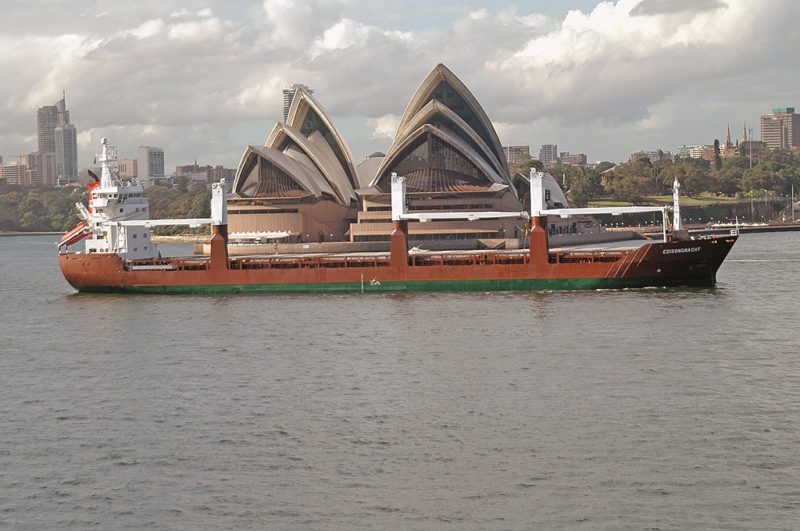
Apollogracht was chartered to Dutch salvage company Multraship Salvage in July, 2004 to offload 10,000 tonnes of fertiliser from a bulker that had run aground in shallow water off the Danish Great Belt, and Alexandergracht repeated the same operation for Multraship Salvage in February 2008 after another bulker had run aground near the island of Samos in the Danish Great Belt.
The ‘E’ class of bulkers of 12,750 dwt to a Ulstein of Norway design was completed in 1995 as Edamgracht, Eurogracht, Edisongracht, Eemsgracht, Egelantiersgracht, Egmondgracht, Elandsgracht, Emmagracht and Erasmusgracht, and all nine were still in service until recently with the company on Round the World services with calls at British ports such as Hartlepool and the Tyne to load reels of flexible pipeline for the oil industry and any other cargo that offered. A large Spliethoff’s fleet of 56 ships was being operated in 1998, while the Mammoet Shipping fleet of heavy lifters numbered a dozen ships, with a 70% stake taken in 1995.
During October 2005, Group vessels were making regular monthly breakbulk calls at Curacao on the service between Gdynia, Antwerp and Bilbao to the Caribbean islands, and Trinidad and Venezuela. Various sizes of mini-bulkers ranging from 8,000 dwt to 20,000 dwt are used on the service, with ships sometimes sailing back to Europe by way of the Panama Canal and the Far East. Soon afterwards, the export traffic of forestry products from Finland to South America by Finnish forestry giant UPM-Kymmene was handled by Spliethoff’s, in a deal worth €100 million with some 3.5 million tonnes of cargo including clay shipments from North America to Brazil and to Europe.
The co-operation between these two companies has since been extended, and then led to sixteen new mini bulkers entering service during 2009, eight ‘D’ class of 18,500 dwt equipped with three 120 tonne heavy lift cranes (Damgracht, Deltagracht, Dijksgracht, Danzigergracht, Diamantgracht, Dolfijngracht, Donaugracht, and Dynamogracht), and eight ‘F’ class of 12,750 dwt and equipped with three 80 tonne cranes (Floragracht, Florinjgracht, Fagelgracht, Flevogracht, Fortunagracht, Floretgracht, Faunagract and Fleurgracht). Floragracht transported a cargo of ten empty flexible pipe reels and containers to Rio de Janeiro in August 2017, followed by heavy lift of a historic diesel locomotive from Milwaukee to Antwerp for onward delivery to be restored by a railway museum in the Netherlands, discharge took place on 8th November 2017. Dynamogracht loaded a full general cargo in May 2018 at La Spezia, Livorno, Pula, Porto Marghera, Ceuta and Motril in Southern Spain for Baltimore, Houston and Vera Cruz in Mexico. A container was packed with 10.5 tonnes of ship’s spare parts including aluminium ladders, stack bridges, life jackets, nets, bag inflators, air cushion nozzles and other equipment and was part of the cargo destined for Houston in Texas.
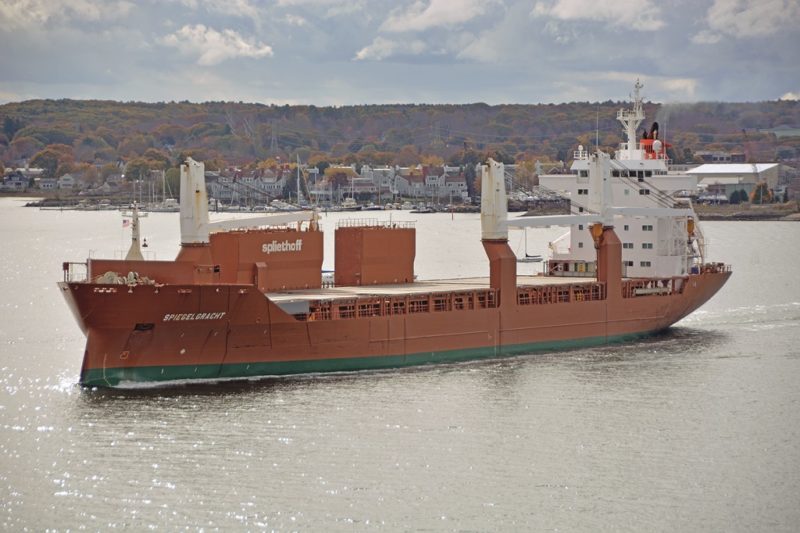
A fleet of 56 short sea and deep sea ships was traded during Millennium year, all with brown hulls with green boot topping, and orange funnels with a black ‘S’ on a diagonally quartered white, red, orange and blue houseflag. The company had unveiled its most ambitious newbuilding programme during the year, ordering 14 ‘S’ class multi – purpose side loading forestry and paper carriers of 21,400 dwt to a resourceful and versatile design. The class were built at the Stoczia Szczechin, Mitsubishi Heavy Industries at Shimonoseki, and Tsuneishi Zosen yards. The ‘S’ class design featured five side loading ports, three heavy lift cranes of 120 tonnes capacity and flexible hold layouts.
Schippersgracht was launched first at Szczecin in March 2000 and was followed by Scheldegracht, launched at Szczecin on 1st April 2000, Sluisgracht launched at Szczecin on 1st May 2000, and then Singelgracht, Slotergracht, Snoekgracht, Spaarnegracht, Spiegelgracht, Stadiongracht, Spuigracht in 2000, and Statengracht, Suomigracht, Saimaagracht and Sampogracht were completed in 2004. They have high service speeds of 20 knots powered by 6-cylinder four stroke Wartsila 6L64 diesels. The class are ideal for transporting yachts and wind turbine parts, as in 2011, Spiegelgracht and Deltagracht transported wind turbine parts including yellow transition pieces (T.P.s), towers, nacelles and blades manufactured by the Danish company Vestas, established in 1979. Spiegelgracht carried ten disassembled wind turbines from Esbjerg to Curacao, while Deltagracht carried 21 disassembled turbines from Esbjerg through the Panama Canal to Portland (Victoria) in Australia, where Vestas have another wind turbine manufacturing plant, commissioned in August 2005. Singelgracht transported wind turbine parts including T.P.s, towers, blades and nacelles from Esbjerg to Australia in February 2016.
Six ‘M’ class of 11,750 dwt were completed during 2012 as Maasgracht, Marsgracht, Merwedegracht, Minervagracht, Molengracht and Muntgracht. Muntgracht transported long pipes in her holds and on deck from Aviles to Flushing in March 2013. A further twenty newbuildings were on order, mostly in China, and all of these company ships are powered by Wartsila 46F propulsion systems.
Five ‘H’ class of 12,750 dwt were in service by 2018, and were joined by the purchase of five Hansa Heavy Lift (HHL) ships for the ‘H’ class in April 2019, while five further HHL heavy lifters of 20,100 dwt were added to the ‘P’ class at the same time. Ten ‘P’ class of 20,000 dwt, comprising seven P-14 types (1,400 tonne lift) and three P-8 types (800 tonne lift), were in service by December 2020 as Palmgracht, Pauwgracht, Plantijn-gracht, Paleisgracht, Pijlgracht, Poolgracht, Parkgracht, Prinsengracht, Pietersgracht and Pottersgracht.
Plantijngracht arrived in Grand Harbour at Valletta in Malta on 15th March 2021 on her maiden call there and berthed at the MMH Facilities wharf to load six large motor yachts weighing up to 266 tonnes in weight. The loading and discharge took three days to accomplish, and she sailed with the motor yachts for discharge at Castellon in Spain.
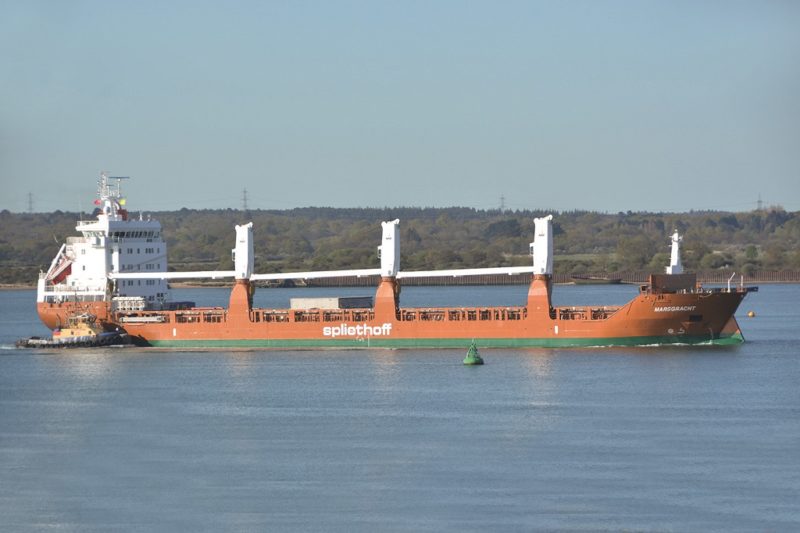
BIG LIFT
The current very large capability of the Spliethoff’s heavy lift ships stems from the Mammoet company, which was the product of the merger of three well known Dutch transport companies between 1971 and 1973, namely HTM Goedkoop, Van Wezel and Stoof. Mammoet dominated the heavy lift industry on land and sea for three decades until the Millennium. A huge Mammoet Transport land-based organisation had equipment consisting of two hundred cranes with lifting capacities of up to 2,000 tonnes, 150 heavy duty trailers, 100 heavy duty trucks, twenty self-designed Hydra-Jack lifting systems with total capacities exceeding 7,000 tonnes, and a massive number of forklifts. The Hydra-Jack system used an arch framework to provide a combination of hydraulic and electric powered lifting units capable of lifting far heavier items than standard crane systems.
At sea, Mammoet Shipping had both ro-ro and lo-lo vessels that began operations in 1970 with Happy Pioneer of 2,826 dwt and two heavy lift cranes, and had been converted from the sludge carrier, Sir Joseph Rawlinson, built by the Lamont yard at Port Glasgow in 1964. Happy Rider and Happy Runner of 2,766 dwt were built in 1976 with bridge forward and two heavy lift cranes, and were followed by Happy Mammoth in 1981 of 7,190 dwt, the former Docklift 2 built in 1967, and Happy Mariner of 4,100 dwt, the former Docklift 1 in 1982. The semi-submersible Docklift 1 was built by the Verolme yard at Huesden in 1972 as the first purpose built heavy lifter on dimensions of 105.7 metres by 20.53 metres by 10.5 metres with a loaded draft of 5.0 metres and was powered by six Caterpillar diesel engines of 5,100 bhp to give a service speed of 12.75 knots. All types of floating cargo could enter its open deck via the enclosing stern door, which was then closed and the ship deballasted. The two Docklift ships had girder type heavy lift cranes of 320 tonnes lift when used in tandem, and a stern door, with Docklift 1 broken up in 1986. Happy Buccaneer, launched at Innoshima on 1st March 1984 and completed later that year, was a big step forward in lifting capacity of 1,100 tonnes (later increased to 1,550 tonnes in 2006 at a safe working load of 29.0 metres outreach) from twin cranes, and a clear deck area of 2,275 m2.
Mammoet Shipping became a fully owned subsidiary in 1976 of KNSM of Holland with Caribbean trading routes, and in 1979 it took over Dutch rival Big Lift, a name that had originally being pioneered by Van der Laan, a subsidiary of Holland America Line. In 1981, Nedlloyd merged with KNSM and gave Mammoet Shipping a new parent and a new role as the Nedlloyd Heavy Transport Division. In 1983, BBI was acquired to give ferry trailer transport operations between the U.K. and Continental Europe as Mammoet/BBI, and in the following year Mammoet Heavy Lift Partners was formed from Mammoet Shipping, Project Carriers (Hansa Line) and Sloman Neptun Schiffarts with a combined fleet of sixteen heavy lift ships.
Mitsui-OSK Line joined Mammoet Heavy Lift Partners in 1987, and COSCO of China in 2001. In 1988, further consolidation was achieved by the merger of Mammoet Shipping with Hansa Line to form Mammoet-Hansa Line A. G. of Bremen, a German subsidiary. Heavy lift ro-ro vessels such as Enchanter (now renamed Han Yi), Encourager (sold for breaking up at the end of 2000), Envoyager, Enlivener, Project Arabia, Project Europa, Project Orient, Thor Scan and Titan Scan increased the size of the fleets of the Dutch and German Mammoet companies.
A 70% holding in this expanding Dutch heavy lift company of Mammoet Shipping was acquired by Spliethoff’s during 1995, retaining the Mammoet name until the end of Millennium year when it was changed to Big Lift on 1st January 2001. Nedlloyd sold the land based Mammoet Transport to Van Seumeren of Holland during 2000. A trio of single screw heavy lifters had been completed in 1996 by the Dutch De Merwede and Vlissingen yards in Happy River, Happy Ranger and Happy Rover of 15,634 dwt, and they are equipped with twin rotating cranes of 400 tonnes capacity, and a clear deck area of 1,525 m2, and thus able to carry the same amount of heavy lift cargo, ro-ro cargo or containers as their earlier twin screw near sister, Happy Buccaneer of 1984.
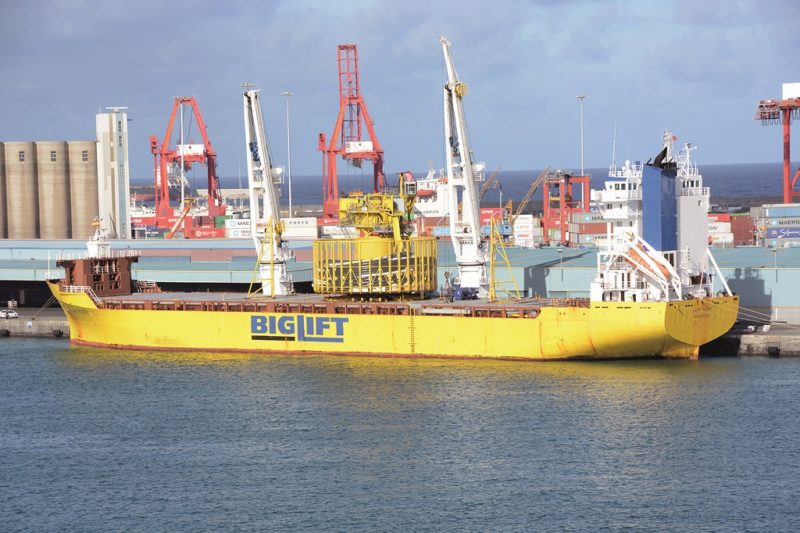
The main deck of this quartet of heavy lifters (the ‘R’ class plus Happy Buccaneer) was as wide and flush as possible to the inner side of the hull, with the main cargo gear on the starboard side. The two cranes can turn through a full circle to give an outreach of nine metres on the port side and a much larger outreach of thirty metres on the starboard side. The hold is covered by heavy covers which during lifting operations can be used as floating pontoons on the opposite side of the hull where the heavy lift is being hoisted to give stability. The lower part of the hold and a ‘tween deck accessed from the stern door and ramp can be used as storage to transport containers of two tiers in height.
In 2000, a quartet of Chinese built heavy lifters of 8,000 dwt joined Big Lift from West African Shipping in Traveller, Tramper, Tracer and Transporter, each equipped with two 275 tonne cranes, one to port and one to starboard. The Big Lift fleet of thirteen heavy lifters with lifting capacities up to 2,200 tonnes, and ro-ro capabilities up to 2,500 tonnes were used in project cargo heavy lifting worldwide as part of the Spliethoff Group.
Five new heavy lifters were completed in 2011 as Happy Delta, Happy Diamond, Happy Dover, Happy Dragon and Happy Dynamic of 14,784 grt and 18,276 dwt on dimensions of 156.0 metres by 26.0 metres by 10.0 metres and equipped with twin cranes of 400 tonnes lift, one crane of 120 tonnes lift, and a clear deck of 1,709 m2. Super fly jibs at the top of the heavy lift cranes began to be used in 2012. Two heavy lifters of even greater capacity followed in Happy Sky of 2013 with twin heavy lift cranes of 900 tonnes lift and a clear deck of 1,742 m2, and Happy Star of 2014 with twin heavy lift cranes of 1,100 tonnes lift to give a huge lift if used in tandem of 2,200 tonnes with a clear deck of 1,716 m2 and a ro-ro capability of 2,500 tonnes. They have yellow hulls with Big Lift in blue, and yellow funnels with Big Lift in black.
Big Roll was formed in 2013 by Big Lift and Roll Dock to operate specially designed module carriers. Four new ro-ro vessels with clear decks of 5,250 m2 for heavy lift cargo joined the fleet in 2017/18 as the yellow hulled Big Roll Baffin, Big Roll Bering, Big Roll Beaumont and Big Roll Barentsz with dimensions of 173.0 metres by 42.0 metres by 6.1 metres with their forward navigating bridge placed above a high bow and a clear deck aft.
They have a red funnel with Big Roll in white. The blue hulled Korean heavy lifters CY Interocean I and CY Interocean II with dimensions of 153.0 metres by 40.0 metres by 5.3 metres joined the twin screw Big Lift Baffin and Big Lift Barendsz in a pool operated commercially by Big Lift in the oil, LNG and gas markets in March 2019. The Korean pair have a shallower draft and are able to enter a wider range of ports. They are owned by Chung Yang, established in 2001 and currently with three heavy lifters.
On 21st March 2019, the twin screw Big Lift Baffin sailed from Vlissingen transporting the three legged jack-up rig Exomina of 12,000 tonnes weight on her deck for West Africa on a three week voyage. The weight of the triangular shaped rig was spread laterally across the wide deck of the heavy lifter with all three legs overhanging her hull. The heavy lifter had ballasted down using her own pumps, and used her engines, two bow anchors, four strong cross wires attached to her own winches to get the massive rig loaded on her deck, assisted by a tug at her stern. The loading and unloading processes were each accomplished in one day to keep to the tight schedule.
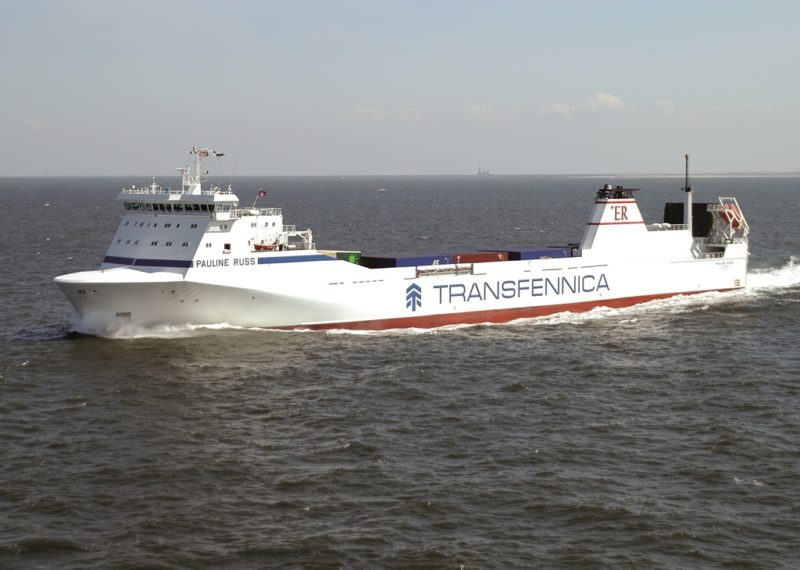
In December 2019, three Post Panamax Gantry Cranes were delivered to the Port of Savannah Authority in Georgia (USA) from Nantong in China by Big Lift Baffin. The voyage took 54 days via Cape Town and South Africa at an average speed of twelve knots. The gantry cranes were transported standing vertically, and the discharge process took three days as the cranes were moved so that their bogies were rotated to stand near the edge of the Savannah quay. The gantry cranes as transported each weighed 800 tonnes, and when fully assembled at Savannah the weight had increased to 1,369 tonnes. The cranes stand 96 metres above the water and can operate across all 22 containers of the width of a container ship. Big Lift Barendsz repeated this heavy lift voyage in March 2021 with three more Super Post Panamax gantry cranes for the Port of Savannah from Nantong.
Four grey hulled Chinese heavy lifters joined Big Lift in 2020 in Da Fu, Da Hua, Da Qiang and Da Zhong with two cranes on pedestals of capacity 250 tonnes and another of 30 tonnes capacity, on dimensions of 153.0 metres by 23.0 feet by 6.5 metres. They are ideal for carrying horizontal petroleum reactors at the sides of their hulls, and have Big Lift in black underlined in blue and black on the sides of their hulls. Two smaller heavy lift ships with two deck cranes are currently on long term charter to Big Lift as Coe Leni of 9,627 grt and 12,696 dwt and able to lift loads of 300 tonnes when both cranes are used in tandem, and Bandura of 5,424 grt and 8,305 dwt with port side cranes of 40 tonnes and 32 tonnes lift capacity.
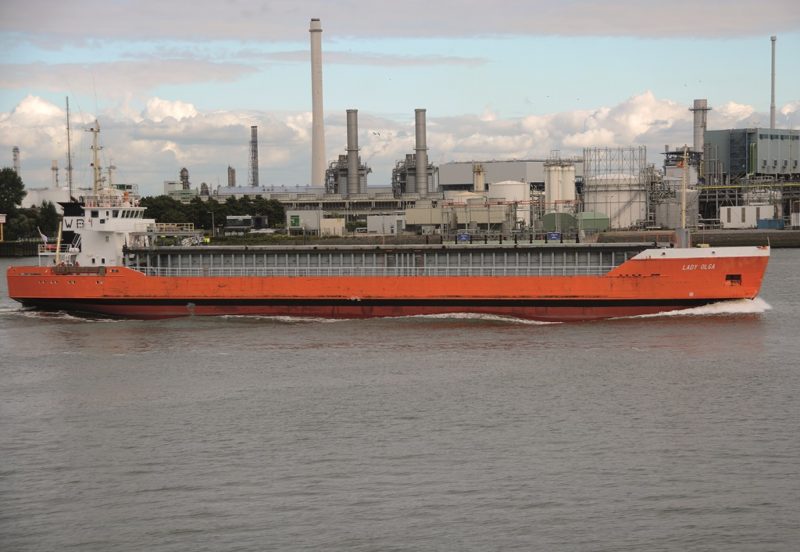
TRANSFENNICA
Transfennica was established in 1976 by three Finnish timber and paper producers in UPM-Kymmene Corporation, Metsa-Serla Corporation and Myllykoski Paper O/Y – to transport Finnish timber, board paper, paper rolls and forestry products as well as general cargo including Sto-Ro, containers, trailers, cassettes, ro-ro cargoes and crates of machinery and machine tools, and IMDG (International Maritime Dangerous Goods) classified goods and temperature controlled units. The voyages from Finland and Baltic countries to the ports of Northern Europe are controlled by offices in Amsterdam, Antwerp, Gydnia, Hanko, Kotka, Helsinki, Lubeck, Paldiski (Estonia), St. Petersburg and Tilbury or Felixstowe. The Head Office was in Helsinki until the company was sold to Finnlines A/B in 2000, with a majority holding acquired by Spliethoff’s in 2002, and full control later. The Head Office today is at Spliethoff’s headquarters in Amsterdam, with subsidiary companies in the U. K., Belgium and Germany.
Ro-ro ships over the last five decades have included the sisters Heralden and Transgard built in 1996 of 10,570 grt and 7,620 dwt with dimensions of 139.4 metres by 22.7 metres by 7.0 metres with a service speed of 20 knots. Two ro-ros out of a sextet operated by Foreland Shipping, a consortium of Andrew Weir Shipping (AWS), Bibby Line, James Fisher & Sons Ltd. and Hadley Shipping, were chartered for civilian work with the other quartet permanently available for military tank transport work. This pair were Beachy Head and Longstone of 23,235 grt and built in 2003. A new sextet of big ro-ros of 28,289 grt and 17,400 dwt entered service between 2006 and 2009 named Genca, Kraftca, Plyca, Pulpca, Timca and Trinca with white hulls with ‘TRANSFENNICA’ in blue together with a Tree symbol, and white funnels with the Spliethoff quartered logo. They have dimensions of 205.0 metres by 25.5 metres, and carry 188 trailers and 640 TEU of containers on a lane length of 2,900 metres, and accommodation for a dozen drivers, at a service speed of 22 knots. Timca was the lead ship of the class and was commissioned at Helsinki on 4th July 2006 as the largest and most useful ro-ro forestry products freight carrier operating anywhere in Europe with three separate lanes leading from the stern door.
In June 2002, Spliethoff’s had acquired a 51% holding in Transfennica O/Y of Helsinki, the leading Finnish transport provider to the Finnish forestry industry. The remaining 49% was acquired in October, 2005 to give complete control to Spliethoff’s from the three Finnish forestry companies that had previously owned Transfennica. Spliethoff’s have increased the current Transfennica fleet to include the sextet of Genca, Kraftca, Plyca, Pulpca, Timca and Trincaand the ro-ro vessels below:-

Corona Sea – a Spliethoff standard type
Hafnia Sea – a Spliethoff standard type
Seagard – a Sietas Type 2 standard type
Bore Sea – on charter from Bore Line
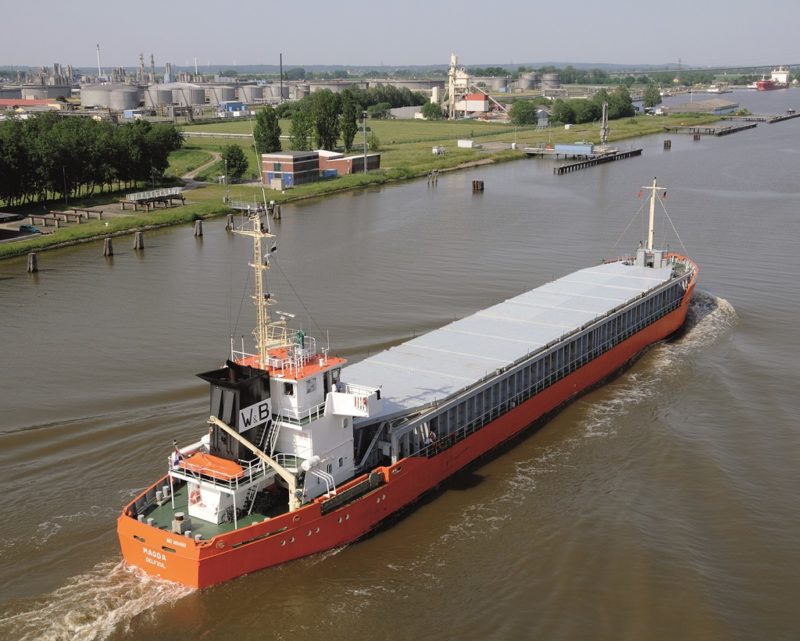
WIJNNE & BARENDS
In September 2003, the Dutch coaster company of Wijnne & Barends of Delfzijl became a member of the Spliethoff Group, with a minority holding having been taken in 2001. This company has a very long heritage, being founded in 1855 to operate on the inland canal system around Groningen by Johan Herman Wijnne and Barend Cornelis Barends. Small owned craft were later able to have access to the sea by the opening of the Eemskanaal from Groningen to Delfzijl in 1867 with a second office opened in this latter town. Shortly afterwards, Johan Herman Wijnne was killed in the first railway accident in Holland on 2nd June 1868, but his partner out of respect retained the name of the company at Wijnne & Barends. This first phase of shipowning lasted only until 1879, with the remaining fleet sold off.
Barend Cornelius Barends died in 1891, and his son Samuel Barends took over the business at the age of 26 years, and was still in control at the end of World War I, with the other directors being his son Zacharias, W. F. Oosterheert and G. Meijer. At the beginning of World War II and the invasion of Holland in May 1940, many Dutch coasters made the short passage across to the Thames to avoid being requisitioned by the Third Reich of Germany. Luctor of 143 grt and built in 1926 was one such Dutch coaster, owned by K. Bakema and built by J. Koster as an auxiliary powered sailing vessel with dimensions of 98.4 feet by 17.7 feet by 7.2 feet. She survived the war and was a member of the Wijnne Barends fleet in 1950. A fleet of seven managed coasters was operated in 1950, six having been built between 1947 and 1950.
A second era of shipowning began in July 1952 with the commissioning of the owned coaster Marie Christine, named for the mother of Barend Zacharias. She had dimensions of 164.7 feet by 26.1 feet by 9.5 feet and was built by the Van der Werff yard at Westerbroek, with a six cylinder 4SA diesel engine by Alphem Motoren. Barend Zacharias died suddenly in 1953, with his third son, Niels Barends, taking over and with J. Sanders as co-director having been in charge of the Groningen office since 1932. A new Head Office was built in Delfzijl with the Barends family taking residence in the floor above, just as they had done in the 19th century at the Groningen office.
The size of the owned and managed fleet then grew rapidly, with 32 ships in 1955, 90 ships in 1960, 77 ships in 1968, and still accounted for over 30 ships in 1973. Marie Christine of 390 grt in July 1952 was followed by Johannes 493/52 (managed), Diannel 397/52 (managed), Santa Margerita 500/52 (managed), Marie 494/52 (managed), Confiance 363/52 (managed), Catharina F 328/53 (managed), Deo Gratias 309/53 (managed), Spica 494/53 (managed), Equator 493/53 (managed), Rini 400/54 (managed), Meteoor 500/55 (managed), Willem Fortuin 341/54 (managed), Viola 398/58, Deo Gloria 458/58 (managed), Mathilde 447/62, Nora 467/62, Menna 450/65, Claudia 500/67, Clarissa 499/67 and Constance 499/68.
Not all of the managed Dutch coasters in the fleet were new vessels, with Saba of 400 grt and built in 1931 as Cornelia B having a career of 35 years until her cargo of coal shifted on 21st April 1966 and she capsized and was lost off Land’s End while on a voyage from Port Talbot to Rouen. She had been refitted and given the name of Saba in 1962. Other old timers in the post-war fleet included Gre of 148 grt built in 1929 by the Noord Nederland yard at Groningen, Mimosa of 183 grt built in 1929 by the Van det Werff yard at Hoogezand, Tanny of 199 grt built in 1932 by the Van der Werff yard at Hoogezand as Constant, and Donata of 200 grt built in 1932 by the Van Diepen yard as Cateli. These old timers were small in dimensions, just typically 103.0 feet by 21.0 feet by 8.6 feet.
A second owned Marie Christine was completed in June 1960 as a ‘paragraph’ coaster of 999 grt by the Voorwaarts Scheeps yard at Hoogezand on dimensions of 229.5 feet by 34.9 feet by 13.3 feet. She had a single hold and hatch with a grain capacity of 72,500 cubic metres and a twelve cylinder 2SA Vee diesel engine aft built at Appingedam. She gave twenty years of service to Wijnne Barends.
An owned and managed fleet of thirty coasters was operated in 1974, the largest of which was Isabel of 1,404 grt and built in 1972. The fleet in 1980 consisted of fourteen coasters with six owned and eight managed, the six owned being Marie Christine 999/70, the sisters Inger, Isabel and Irina of 1,404 grt, and the sisters Mathilde and Menna of 1,600 grt and built during 1977/79. A decade later in 1990 the size of the fleet was twenty coasters with thirteen managed as well as the owned Inger, Mathilde, Menna and the newer Clarissa, Claudia, Constance and Nora of 2,800 gt and completed between 1982 and 1985.
At the Millennium, the fleet consisted of 32 coasters with the owned Irina of 3,322 gt completed in 1997, and Claudia of 4,235 gt completed in 1999, together with thirty managed coasters. Morgenstond II was one of the latter managed coasters, managed for C. V. Drent & Son and of 3,782 gt and completed in 1997. Their current fleet is a large one of 33 coastal cargo and feeder container ships, with eighteen having ‘Lady’ prefixes to their names e.g. the sisters Lady Carina, Lady Christina, Lady Clarissa and Lady Claudia of 5,438 dwt and completed between 1999 and 2001 by the Niestern Sander B.V. yard at Delfzijl as Carina, Christina, Clarissa and Claudia respectively. Most of the fleet received the ‘Lady’ prefix to their names in 2009/10, and four recent additions have been the new orange hulled low air draft coasters Lady Helene and Lady Marie Christine of 3,500 dwt in 2010, and the similar orange hulled Lady Alexandra and Lady Anneke from Groningen Shipyards in 2012. They have hinged foremasts and navigation masts for navigation under low bridges. Managed coasters include Warber, Passaat, Najade and Lammy of 2,800 gt and between 3,150 dwt to 3,500 dwt.
Lady Anne Beau of 4,200 dwt and completed in 2016 delivered the first four monopiles from Rostock on 10th September 2020 to the Frisian Wind Farm in the Ijsselmmer at Breezanddijk in Holland. She and two other ‘Lady’ sisters also transported 23 cargoes of wind turbine parts from Rostock to this wind farm. Four bigger shipments of concrete work platforms at this time were made by the Spliethoff ‘H’ class from Swinoujskie in Poland to Harlinjen.
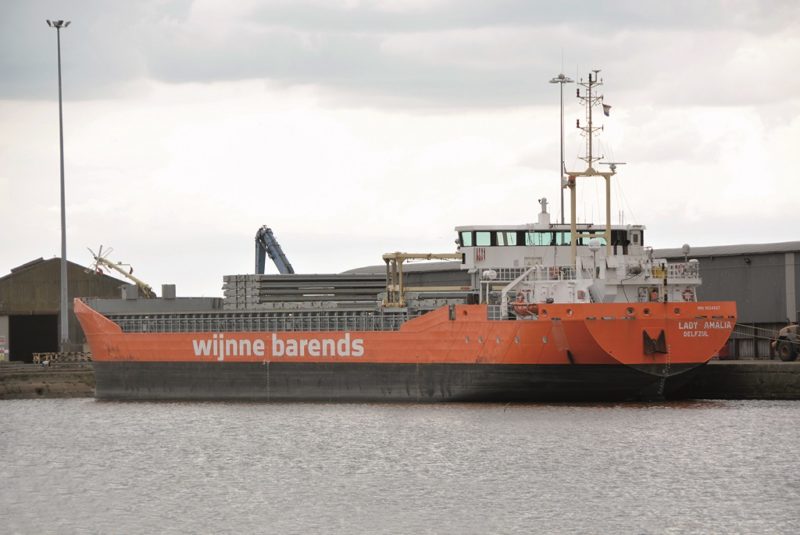
SEVEN STAR YACHT TRANSPORT
Spliethoff’s have been transporting yachts for well over thirty years as their ‘A’ class of 1990 were busy with this trade in that decade, and Aalsmeergracht sailed from Southampton with yachts on 10th October 2000 and arrived at Fort Lauderdale fifteen days later. Seven Star Yacht Transport was founded in 1985 to transport mega yachts, medium sized yachts, and small yachts from the Mediterranean to the Caribbean and vice-versa, as well as to and from other ports throughout the world with sunny havens for yachts. Many yachts of all three sizes can be floated on and off two owned Seven Star vessels or lifted on and off the many heavy lifters of Spliethoff’s, which took over the company in Millennium year. Currently, around two thousand yachts are transported annually to all of the yacht marinas of Charlotte Amalie (St. Thomas), Philipsburg (St. Maarten), Pointe a Pitre (Guadeloupe), Fort de France (Martinique) and the Mediterranean ports of Palma de Mallorca, Genoa and Taranto in Italy, Marmaris in Turkey, as well as to the many sunny American, Pacific and Australasian yacht marinas of Papeete (Tahiti), Port Everglades (Florida), Golfito (Costa Rica), Ensenada (Mexico), Auckland and Brisbane and vice versa at the end of the yachting seasons in these areas. Yacht Racing Teams of several big racing yachts in their fleet can be handled with prompt delivery. Barges, small warships, tugs and small dredgers are also carried, with a plan worked out beforehand of where each transported yacht or vessel is to be placed on the floor of the heavy lift carrier.
The most common route of the three specialised yacht transporter vessels, plus Spliethoff’s heavy lifters on yacht transfer charters, are from Fort Lauderdale to Palma de Mallorca and Genoa five times per year, and three times per year from Fort Lauderdale to Marmaris, and at least one or two arrivals per year in each of the other ports mentioned above. The three vessels are operated by Seven Star Yacht Transport and are named Yacht Express, Yacht Servant and Super Servant 4.
Yacht Express was built by the Nantai Raffles yard in Shandong Province in China in 2007, having been skidded off the construction berth onto four connected floating submersible barges on 15th January 2007, and four days later floated off the barges at high tide and moored alongside the construction berth. She was delivered to Dockwise Yacht Transport (DYT) in October 2007 with dimensions of overall length 685.7 feet, moulded beam of 105.64 feet, moulded depth of 27.89 feet and loaded draft of 19.03 feet.
The maximum submerged depth is 46.0 feet with a working deck length of 541.34 feet and a deck width of 101.71 feet, with yachts and other craft normally secured in three lanes. While the yachts are being loaded or offloaded and moved in and out of the stern, she is anchored at the bow and the stern, with stern thrusters able to prevent her swinging with the tide. Accommodation is provided for yacht owners in luxury cabins, complimentary cabins for all crews onboard, as well as a conference room, media room, atrium with lounge, swimming pool, fitness room, laundry facilities, and some additional features to make the voyage as pleasant as possible.
Yacht Express is semi-submersible and operates a unique method of float on and float off, with all yachts covered so that they are not sprayed by seas breaking over the dock bay. The dock area is an impressive 55,060 square feet, with ballasting and deballasting done by four main ballast pumps of a total of 4,800 cubic metres per hour, two general service pumps of a total of 420 m3 per hour, an emergency fire pump of 72 cubic metres per hour, and an ejector pump of 200 cubic metres per hour. Twin ten tonne cranes with an outreach of 15.0 metres are used for cargo and stores loading. She is powered by twin Wartsila diesel engines located at the sides of the stern of 8,700 kilowatts power each driving thrusters to give a service speed of 18 to 19 knots, with two Wartsila generators and a Volvo Penta generator to produce electrical power.
She makes her regular Transatlantic voyages in ten to fifteen days dependent on weather conditions, with owners enjoying the luxury facilities for the extra days on the voyage when speed is reduced due to weather conditions. She is measured at 17,951 gt and 10,969 dwt and is registered at Curacao and classed by Det Norske Veritas. She ballasted right down to her marks to unload a cargo of yachts in Sydney Harbour (NSW) on 13th January 2016 at the anchorage near Shark Island and Rose Bay. Dockwise Yacht Transport (DYT) was taken over by Spliethoff’s during 2013.
The second specialised yacht transporter vessel is the brand new Yacht Servant delivered on 4th January 2022 at the Yantai Raffles yard on the Shandong Peninsula in Southern China. The keel was laid on 30th July 2020 and hull construction took 17 months on dimensions of length overall 213.7 metres, moulded beam of 46.0 metres and a loaded draft of 4.6 metres with a deck area of 6,380 m2 (30% more space than near sister Yacht Express). She is an upgraded near sister of Yacht Express but carries a larger crew of 42 compared with only 30 on Yacht Express. She made her maiden voyage from Shanghai to the Panama Canal, and returned with cargo to China to transport more cargo to Colombia. She arrived in the Caribbean in May 2022 to begin her sailing schedule from Florida to the Caribbean and the Mediterranean. She can operate in water with a depth of ten metres, five metres less than Yacht Express.
The third specialised yacht transporter vessel on charter to Seven Star Yacht Transport is Super Servant 4 with a crew of 24 heavy lift specialists, and of 12,642 gt, 14,112 dwt, and completed in 1982 at the Oshima Shipbuilding yard. She has dimensions of overall length of 169.50 metres, moulded beam of 32.31 metres, loaded draft of 6.26 metres, and is also registered at Willemstad on Curacao. She is twin screw and powered by a Stork Werkspoor diesel engine of 4,248 bhp to give a service speed of 11.6 knots. She was originally owned by Wijsmuller of Holland, but now her registered owner is Shuttle Shipping N. V. and the operator is Spliethoff Transport B.V of Curacao. She has loaded yachts and floating vessels at the Waalhaven in Rotterdam in July 2019 and May 2021, and operates to Port Everglades, Charlotte Amalie on St. Thomas, and San Pedro de Macoris in the Dominican Republic from Palma de Mallorca, Genoa, Flushing, Toulon, Ijmuiden and Rotterdam.
Spiegelgracht of the Spliethoff ‘S’ class sails in November every year from Palma de Mallorca, Genoa, Southampton and other Mediterranean ports to the ports in the Caribbean mentioned above, and then returns the same yachts to their Mediterranean marinas every May for the summer cruising season on charter to Seven Star Yacht Transport, a member of the Spliethoff Group since 1999. During transport, the yachts are stored in specially designed cradles on the ship’s deck preventing them from suffering damage during the voyage. The return voyage of the yachts in May provides more employment for the vessel, which has also carried ten wind turbines from Esbjerg to Curacao, and heavy reels of flexible pipe for the oil industry from the Tyne to Houston or to oilfields around the world. Spiegelgracht later sailed from Greenock on 29th June 2019 from Greenock to Baltimore with a cargo of motor yachts and containers, arriving on the Eastern Seaboard of the U.S.A. on 10th July 2019. Damgracht of the Spliethoff ‘D’ class also transports yachts on occasion, having arrived at Fremantle from Genoa on 28th November 2021 to unload her motor yachts in time for Christmas. She was berthed at Brisbane in the first few days of 2022 at the time of writing this article. The sister Diamantgracht sailed from Singapore on 31st July 2017 for Darwin with a deck cargo of yachts and barges and arrived in Australia on 8th August 2017.
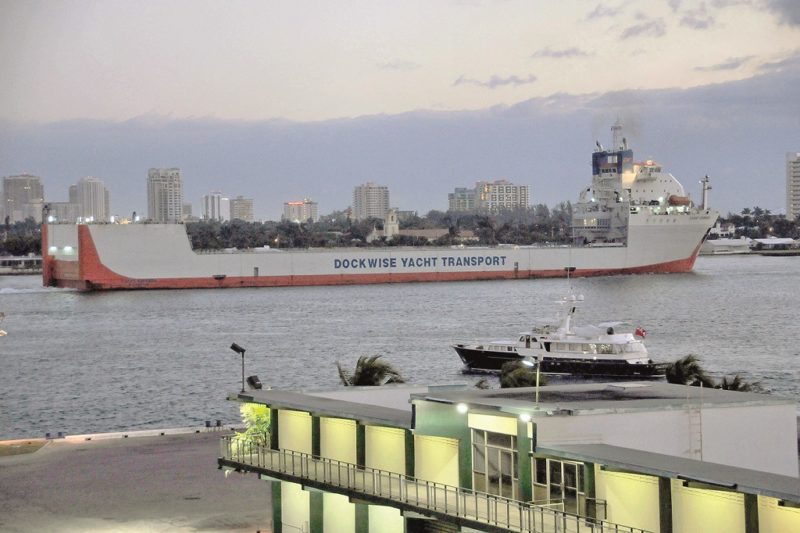
BORE LINE
The Bore Steamship Company was formed in Abo, now Turku, in Finland, in 1897, with the first steamer Bore of 800 gt completed in the following year for year round passenger and cargo traffic from Turku to Mariehamn in the Aland Islands and Stockholm. Unfortunately, she ran aground in dense fog on 31st December 1899 and was declared a constructive total loss. She was refloated in 1901, repaired and purchased back from her insurers and renamed Bore I. Since then, most of the owned ships have had a suffix of a numeral following ‘Bore’ e.g. Bore II 820/07, Bore III 1,168/15, Bore IV 1,691/07, Bore V 787/96, Bore VI 1,500/19, Bore VII 1,179/23, Bore VIII 4,528/07, Bore IX 4,500/04 and Bore X 5,058/39.
In 1924, the Bore Steamship Company began cargo services from Finnish and Baltic Sea ports to North Sea ports, and two years later became a member of the Finland-South America Line owning cargo-liners of 7,500 dwt and trading deep-sea until 1965. Bore X was completed in 1939 by the Gotaverken yard in Gothenburg for the Finland-South America Line and survived World War II until allocated to the U. S. S. R. in 1945 and renamed Marshal Govorow, trading until deleted from the register in 1971.
In 1958, the Bore Steamship Company, the Finland Steamship Company, and Rederi A/B Svea founded the important Baltic passenger Silja Line for services between Finland and Sweden. Twin funnelled passenger ferries such as Bore III, built in 1952 by the Oskarshamns yard, and Bore, built in 1960 by the same yard, had a passenger capacity of 1,100 with a service speed of 15 knots from a single steam reciprocating engine plus an exhaust turbine driving a compressor. Botnia of 3,514 grt was completed in 1967 by the Wartsila yard in Helsinki with accommodation for 1,000 passengers with 198 passengers berthed in cabins, and 200 cars accommodated on her car deck. In 1975, she moved to Spanish waters for Trasmediterranea as Ciudad de la Laguna, and then to Canarian waters for Armas Line as Volcan de Tenagua in 1999. She made day cruises around the island of Gran Canary, which I found very refreshing while on holiday there. She ran aground and was lost at Puerto Rosario on Fuerteventura in 2008.
Six stern loading sisters ro-ros were completed between 1967 and 1972 of 3,350 grt with space on their car decks for 385 cars, 72 trucks and 105 TEU of containers by the Rauma Repola yard at Rauma in Finland. They were named Bore V, Bore VI, Bore VII, Bore IX, Bore X and Bore XI. The sextet were joined by a bow and stern loader ro-ro in 1972 named Silvia and built at Nystad in Sweden with space for 260 cars and 45 trucks on her car deck. A larger bow and stern loader passenger ferry of 12,343 grt was delivered in 1975 by the Dubigeon Normandie yard at Nantes carrying 1,000 passengers with 740 passengers berthed in cabins, and with space for 300 cars on her car deck. Four Pielstick diesels each of 6,000 bhp gave Bore Star a high service speed of 22 knots on Silja Line service until she was sold in 1986 and renamed Orient Express, becoming Euro Sun in 1989, Orient Sun in 1991 and Wasa Queen for Wasa Line O/Y A/B in 1992.
In 1987, the Bore Steamship Company was taken over by Rettig O/Y of Finland and a new company, Bore Line, was formed to operate Baltic Sea and North Sea freight traffic, and four years later these operations were transferred to Finnlines. Passenger carrying was given up in the late 1980s, and in 1998 the company was operating four freight ro-ros in Finnbeaver of 4,690 dwt built in 1991, Finnseal (ex Bore Nordia) of 5,282 dwt built in 1991, Bore Sea of 4,234 dwt built in 1990, and Trans Nordica (ex Bore Song) of 6,100 dwt and built in 1977. In 2009, a dozen ro-ros and feeder container ships of around 3,750 dwt to 4,950 dwt were being operated with three on charter to UECC (United European Car Carriers) as Auto Baltic, Auto Bank and Auto Bay.
The current Bore Line fleet consists of 7 large freight ro-ros on services to North Sea ports including Teesport.
These are :-
Bore Bay of 10,527 gt, 7,300 dwt built in 1997 with a lane length of 1,511 metres
Estraden of 18,205 gt, 9,700 dwt built in 1999 with a lane length of 2,270 metres
Norsky of 20,296 gt, 11,400 dwt built in 1999 with a lane length of 2,630 metres
Norstream of 20,296 gt, 11,400 dwt built in 1999 with a lane length of 2,630 metres
Seagard of 10,488 gt, 7,226 dwt built in 1999 with a lane length of 1,609 metres
Bore Sea of 25,586 gt, 13,535 dwt built in 2011 at Flensburg with a lane length of 2,863 metres
Bore Song of 25,586 gt, 13,535 dwt built in 2011 at Flensburg with a lane length of 2,863 metres
All of this septet have service speeds of 19 to 20 knots, with buff funnels with a white cross on a blue band, and white hulls with green boot topping, or blue or green hulls if on charter. A newly designed ro-lo, delivered in 2021 on dimensions of 120.0 metres by 21.0 metres and 7,000 dwt, has her bridge forward, engines aft, and a long, clear deck area. All of the current ro-ro fleet are classed to Finnish and Swedish Ice Class 1A for service in severe winter Baltic ice conditions. Bore Line acquired Rederi A/B Engship and Bror Hussell Chartering A/B in 2006/07. Rettig O/Y sold Bore Line in 2016 to become a member of the Spliethoff Group of companies.
SUMMARY
The Spliethoff Group has certainly come a long way since their first Dutch motor coaster of 499 grt sailed in 1946, and their Head Office is now in the Radarweg in Amsterdam. The Spliethoff houseflag is a diagonally quartered saltire with orange, red, white and dark blue quarters with a central superimposed black ‘S’. The centenary of the company was celebrated virtually on-line on 11th January 2021 due to COVID-19 restrictions, but all in the company from Vice Presidents down to office workers and seagoing personnel saw this impressive presentation of their important Group milestone.
Today, the trade routes sailed by the Spliethoff Group are worldwide, with many regular services covering Baltic and North Sea trades, the Canadian St. Lawrence and Great Lakes trades, Caribbean, Mexico, Latin American, the East Coast South American trades to Brazil, Uruguay and Argentina, American ports, Far East ports and those in Australia and New Zealand, the Mediterranean and the Black Sea, North Africa, and West African ports with shipments of cocoa beans and general cargo back to the Mediterranean and North African ports and North West European ports.
Two Transatlantic trades are important, firstly the Cleveland Europe Express (CEE) service to the Canadian and American Great Lakes ports of Picton (Ontario) and Cleveland (Ohio) from Antwerp. This service has been twice monthly for many years e.g. Fortunagracht was running on the service in April 2014 with cargoes of timber, steel and containers. The service was stepped up to three times monthly by chartered ships such as the container ship Peyton Lynn C of 870 TEU (9,935 gt and 12,193 dwt) and completed in 2007 at Jinjiang in China as Eemsdijk. She is owned by Doornekamp Shipping Services and sailed from Antwerp for the first time on 23rd August 2021 for the Doornekamp wharves in the Great Lakes using the Welland Canal, the round voyage taking one month.
Secondly, the regular Medliner service from Mediterranean ports to ports in the U.S.A. and Central America. Mediterranean loading ports are Gemlik, Izmir, Monfalcone, Sagunto, Porto Marghera (Venice) and Genoa to Port Everglades, Chester, New Orleans, Houston and Vera Cruz in Mexico. Two sailings per month are made with increased frequency in future.
Biofuel bunker blends have been used since June 2021 on trials on two ships, Big Lift Baffin and Flevogracht, to test whether biofuels can be used in combination with heavy fuel oil. Clients of the Spliethoff Group now have the option from January 2022 of being offered the use of biofuels for certain trades and projects, which inherently give the possibility of emission reductions and lower bunkering costs. Two multi-purpose ‘B’ class of 12,500 dwt, named Bloemgracht and Brouwersgracht, are under construction at the Fujian Mawei yard in China for delivery in June and July 2022. They will be equipped with twin Huisman heavy lift cranes of 500 tonnes capacity, as well as removable pipe laying gantry equipment for the efficient transportation and laying of pipe lines offshore. The pair will have two ‘tween decks and a large deck working area of 5,900 m2.
The huge Spliethoff Group current fleet covers a total of 125 ships in the main Spliethoff’s brown hulled fleet as well as in the five subsidiary companies of Big Lift, Transfennica, Wijnne Barends, Seven Star Yacht Transport and Bore Line. Daily freight rates for heavy lift ships of the 12,500 dwt ‘F’ type have increased to $20,875 in January 2022 compared to only $6,931 in December 2020, as construction projects increase in number e.g. steel and heavy preformed concrete blocks are needed for new ports such as the Port of Ndayane in Senegal, 50 kilometres from the existing port of Dakar. The foundation stone of the new port was laid on 3rd January 2022. The Spliethoff Group will continue growing at a fast pace, and I wish them well.

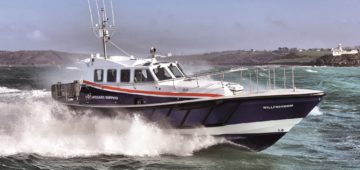


Comments
Sorry, comments are closed for this item